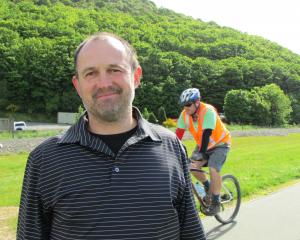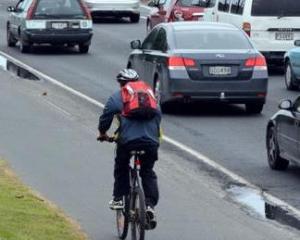A month-long public consultation period on two options for improving cycle safety on the State Highway 1 one-way routes through central Dunedin opened yesterday.
The options, both separated cycle lanes, were identified by a working group - including the New Zealand Transport Agency, Dunedin City Council, cycling advocates and a specialist consultant - as the best option for enhancing cyclists' safety after the council urgently sought improvements following the deaths of cyclists on the one-way streets in 2011 and 2012.
The two proposed options - two one-way lanes (option 1) and a two-way lane (option 2) - would both impact on parking.
Council transportation planning manager Sarah Connelly said at least 185 parks and at most 391 parks would be removed if separated lanes were installed.
If motorists did not park elsewhere, the council would lose about $250,000 to $295,000 a year.
Staff had come up with several ideas to address the changes to parking needed and were seeking feedback.
The ideas included moving affected parking meters, P5s and other restricted-time parks to adjacent streets; promoting parking in existing car parks not at capacity, even at peak times, such as the St Andrew St car park and Great King St parking building; providing about 100 more angle parks in Union, St David, Dundas, Howe and Duke Sts; or, at the extreme end, building a new parking building that would also involve retail or other commercial enterprise.
NZTA projects team manager Simon Underwood said the working group settled on the option of separated cycle lanes after much research.
It decided other options were not as safe for Dunedin, which was in a unique situation given the safety problem was on main arterial routes.
He clarified that some of the trees along the affected sections of road would have to be removed, especially at intersections. Mid-block, the separated cycle lane might go around trees, but that was less likely with option 2, which would probably all trees in its path removed.
The loss of greenery would hopefully be offset by planting in the separating islands or by planter boxes, he said.
Which organisation would be responsible for maintaining the plants was to be determined, as were finer details of the design of the separation, which could involve kerbing, bollards, planted islands or planter boxes.
The traffic lanes would become slightly wider in option 1 and remain about the same under option 2, and existing cycle lanes would become part of the traffic lanes.
At intersections, traffic lights would be phased to allow cars to turn and cyclists to cross separately. Vehicle access to SH1 from properties along the separated lane would not change.
The project would cost between $3.5 million and $4.5 million, depending which option was picked, with the NZTA to cover costs.
Because of the processes required to take place, construction would not begin for two to four years. Ms Connelly said the council's main ''cost'' could be in reduced revenue from parking, but it expected people would park elsewhere.
There were about 100 movements a day on the present lanes, but overseas experience showed consistent increase in use after separated lanes were installed.
Mr Underwood said, following consultation, any recommendation from council staff and the NZTA to the council - which would need to apply to get any project on the NZTA's work programme in 2015-18 - would be based on the issues raised.
''It is not a numbers game as to which option is preferred. Rather, we will consider the issues and concerns people have raised in their preferences.''
Ms Connelly said the council would get a report on the consultation results and seek a decision in February or March.
NZTA Otago-Southland highway manager Ian Duncan said this was the most significant issue the Dunedin community had yet had a say on in relation to cycle safety, and the agency was depending on feedback for direction.
The consultation period on the cycle lane proposals lasts until December 6 and will include three drop-in sessions, online submissions and surveys.
Details are available on the council's and NZTA's website.








